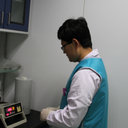Cyanidin-3-O-β-glucoside with the aid of its metabolite protocatechuic acid, reduces monocyte infiltration in apolipoprotein E-deficient mice.
Ключові слова
Анотація
Polyphenols, including anthocyanins, from various plant foods are effective in reducing the severity of atherosclerosis in animal and human studies. Due to the poor understanding of the bioavailability of anthocyanins, the potential antiatherogenic mechanisms underlying the action remain largely unknown. Herein, we found that oral gavage of cyanidin-3-O-β-glucoside (Cy-3-G) could be transformed into protocatechuic acid (PCA), and the plasma maximal levels of Cy-3-G were 3.7-fold lower than that of PCA in the apolipoprotein E (ApoE)-deficient mice. Subsequently, we observed that PCA treatment has a higher capacity than Cy-3-G treatment in decreasing CC chemokine receptor 2 (CCR2) expression in the mouse peripheral blood monocytes (PBMs), along with reducing the mouse PBMs chemokine toward CC ligand-2 (CCL2) in a Boyden chamber. Interesting, in the ApoE-deficient mouse model, orally gavaged with Cy-3-G has a higher ability than gavaged with PCA to reduce CCR2 expression in PBMs. PBMs deprived from the Cy-3-G-treated ApoE-deficient mice have a lower ability than those from PCA-treated animals to migrate toward CCL2. Furthermore, as compared with the PCA group, Cy-3-G treatment more efficiently reduced thioglycollate-induced macrophage infiltration into the abdominal cavity. Thus, we suggest that Cy-3-G may reduce the monocyte infiltration in mice via down-regulation of CCR2 expression in monocytes, at least in part, with the aid of its metabolite PCA. These above data imply that the anti-monocyte/macrophage infiltration property of Cy-3-G and its metabolite PCA may be an important antiatherogenic mechanism for anthocyanins.



